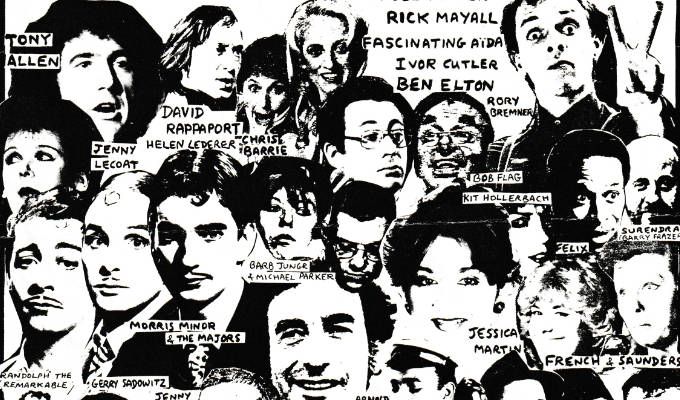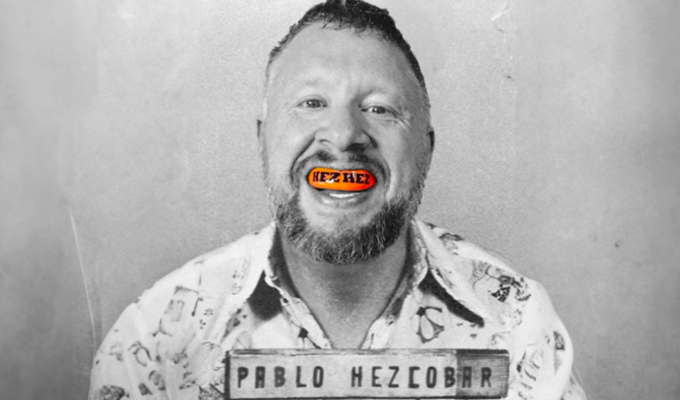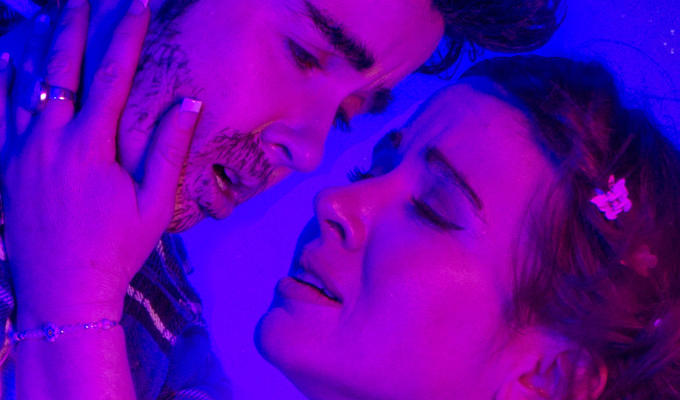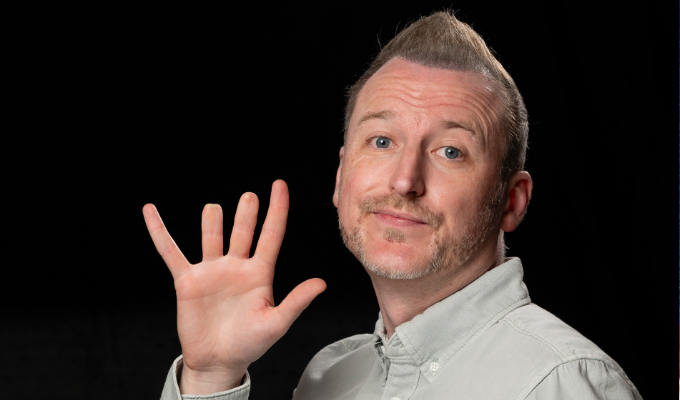
Earth Exchange's hall of fame – and infamy
Part two of our series about the influential London comedy venue
 Following yesterday's introduction to the Earth Exchange – a significant venue in the early days of alternative comedy – today its promoter and compere Kim Wells, left, recalls some of the names, famous and not-so-famous, to have played this unassuming vegetarian cafe in North London.
Following yesterday's introduction to the Earth Exchange – a significant venue in the early days of alternative comedy – today its promoter and compere Kim Wells, left, recalls some of the names, famous and not-so-famous, to have played this unassuming vegetarian cafe in North London.
Tony Allen’s talent transfusion: The Comedy Store comes to Highgate
Gradually talented comedians found their way to the Earth Exchange. These included John Hegley, Norman Lovett, Tony Allen, Bob Flag, Mac MacDonald (the ‘Human Jukebox’ who busked at Camden Lock Market), Andrew Bailey and David Rappaport. I remember David Rappaport and Andrew Bailey once doing a very surreal act where David had his head and shoulders in a parrot’s cage and Andrew fed him through the bars.
I was very lucky - and honoured - that Ivor Cutler agreed (slightly reluctantly) to appear In 1981. He was a well known eccentric, humourist, musician, poet and writer, who appeared in the Beatles’ Magical Mystery Tour film in 1967 and later featured regularly on BBC radio, including John Peel’s influential late night show. He was living in a flat in the same house as Lucy, my Brazilian girlfriend, and the two had become friendly, perhaps because they were both a bit quirky.
He initially resisted my overtures to perform, saying he either performed for large sums of money or charity and my puny offer of 15 quid and a free meal ticked neither box. He eventually relented saying he’d do it for Lucy.
Cutler stormed the place. I remember he read a few extracts from his semi-autobiographical book, ‘Life in a Scottish sitting room’, which made a point of exaggerating Scottishness. He made "Would you like another scone?" sound very sinister: full of implicit menace and puritanical malice. He also played his hallmark harmonium.
Nonetheless the talent pool was still insufficient to support a strong and varied bill every week. In 1981, Tony Allen started introducing comics from The Comedy Store, bringing a very welcome talent transfusion. These seemed very happy to perform for a free vegetarian meal and a small fee from the collection I took from the audience. There were very few other ‘alternative’ comedy venues at the time on which to hone their skills. (At one point, the Comedy Store and Earth Exchange were the only two.)

8th anniversary montage part one (1988)
Ben Elton (1981), Rik Mayall (1982), Nigel Planer (1981), Fascinating Aida (1983), Jenny Eclair (1983), Paul Merton (1982), French and Saunders (1982), Clive Anderson (1983), Julian Clary (1982) and Mark Steel (1983) all performed at Earth Exchange in the early 1980’s. (The dates in brackets give the year of their first performance.) There were also Ronnie Golden (1981), Arnold Brown (1982), Helen Lederer (1982), Fiasco Job Job (Arthur Smith and Phil Nice) (1983) and The Oblivion Boys (Stephen Frost and Mark Arden) (1981).

8th anniversary montage part two (1988)
In the mid to late Eighties, performers adding their names to the roll of honour included Rory Bremner (1984), Jo Brand (1987), Morris Minor and the Majors (1985), Barb Jungr and Michael Parker (1984), Sean Hughes (1987), Chris Lynam (1986), Jeremy Hardy (1984), The Greatest Show On Legs (1984), Jerry Sadowitz (1986), Kit Hollerbach (1985), Neil Malarkey (1985), Mark Thomas (1986), Rob Newman (1988), Phil Cornwell (1985), David Baddiel (1988), Tony Hawks (solo, 1984), Hattie Hayridge (1987), Alan Davies (1989), Kevin Day (1986), Steve Coogan (1988) and Eddie Izzard (1988).
The complete roll of honour encompassed virtually everyone who was anyone in ‘alternative’/new wave comedy in the 1980’s. Apart, that is, from Alexei Sayle and Ruby Wax who both spurned my invitation to perform (Sayle because I said I could only guarantee him eight quid). And Keith Allen who regrettably I never got to ask. As I’d say in my introductory build-up: Ben Elton, Julian Clary, Paul Merton ... The Earth Exchange: where they all started and most of us end up.’
I held on to the wildly optimistic hope that Bob Dylan might pop in and be prevailed upon to play a few songs. Not totally impossible as Dylan was inclined to visit Dave Stewart (of The Eurhythmics) in nearby Crouch End only a mile away and hang out in pubs and restaurants there. A far-fetched fantasy, yes. But, in those heady days, the improbable seemed possible and even the impossible conceivable.
The Hall of Fame
Performers like Fascinating Aida, Arthur Smith and Rory Bremner continued to perform at Earth Exchange for very low fees even when they were on the way up and could command much higher ones.
There were several reasons: the chance to try out new material; the intimate atmosphere and civilised audience; and the desire to support the venue and live entertainment. Some were paying back a debt of gratitude for the venue giving them a chance to get started. John Hegley (at the time part of a theatrical troupe performing for children) did his first gig as a stand-up at Earth Exchange. He later told me he stood nervously at the back plucking up courage to perform.
The prospect of a complimentary meal was a major attraction for many performers. Mark Steel is quoted in Oliver Double’s Alternative Comedy as saying: ‘The brilliant thing is you got ...a free vegetarian dinner. Economically that was quite important.’

The Earth Exchange kitchen
The great advantage of Monday night was that few performers were busy. The disadvantage was this often meant a small audience although sometimes the relatively small space was filled to the ceiling.
Julian Clary also did his first solo comedy gig there in 1982 as agony aunt, Gillian Pieface. His pet whippet, Fanny The Wonder Dog, sat forlornly on a stool next to him, seemingly totally indifferent to what Julian was doing and even yawning at times.
Julian would contrive to make her ‘do impressions’ by, for instance, hanging a string of pearls around her neck to conjure up the Queen Mother or putting a shower cap on her head to evoke the film, Psycho’ Oliver Double reports Julian as saying about Earth Exchange: ‘You didn’t get paid, you got a plate of lentils instead. There wasn’t a stage, you stood in the fireplace among the tables.’ (He would have got paid but only a cut of the collection: probably £10 to £15).

Posters advertising Clary's appearances in 1985 and 1987
When he first started performing in the early 1980s, he claimed there were so few venues he only managed one gig a month. His Gillian Pieface persona – a mix of agony aunt and drag artist - resembled Dame Edna Everage in some respects. Like Edna he would make bitchy remarks about the dress of the audience. I remember him once asking a woman witheringly "Is that gingham?" as if she had committed an egregious sartorial faux pas. He read out letters from his readers asking for his advice. One was signed ‘Head in the Oven’. In 1984, he started billing himself as ‘The Joan Collins Fan Club’. Julian performed at Earth Exchange 13 times between January 1982 and January 1987.
Earth Exchange inspired Bill Bailey to take up his comedy career. In a Guardian interview he said: 'On the invite of a friend, I went to London and we saw a comedy gig in the Archway Road that was comically alternative. It was like a sitcom’s version of what alternative comedy would be. It was an anarchist vegetarian commune called Earth Exchange and it was vegetarian food at the back and alternative so-called comedy at the front.
‘I saw an act called Otiz Cannelloni who did this surreal meta magic and there were storytellers, alternative comedians and John Hegley. He was singing short, intense songs on the mandolin and he had this brilliant stage persona. It was the first time I realised: ‘That’s what I want to do’. It was just a question of how I could engineer my life so I could do it."
His first step was to start a comedy club in his home town, Bath. He describes John Hegley as ‘a big influence. The combination of words, pictures, music and songs. That’s something that has formed the core of my own act’.
It’s great to think the Earth Exchange had so much influence on Bill Bailey although I’m not sure how to take such comments as ‘alternative so-called comedy’ and ‘a sitcom’s version of what alternative comedy would be’. John and Otiz were given the Bailey seal of approval so who was doing ‘so-called comedy’? Me?
Rory Bremner performed there a few days before his Royal Command performance in 1986. I put a sign up on the fireplace (the backdrop of the ‘stage’) advertising this fact but not many people turned up.
Rik Mayall came in November 1982 when he was quite famous (doing his Rik, the poet routine). I didn’t advertise he was coming except to put a badly scrawled, small felt-tip sign up in the venue three days before. The place was packed. I was teaching sociology to sixth form girls in Barnet at the time. One student said, ‘You should have told us, sir: we would have got half of Barnet down there.’ It could have been a nightmare. Imagine the headline: ‘Veggie diners crushed in teenage stampede’.
Not long after this, I heard Mayall was being pursued by predatory groupies, something which, according to the tittle-tattle of the time, he found somewhat distasteful and unsettling. In 1984 (when we were trying - in vain - to write a book on comedy together), Tony Allen told me he thought that alternative comedy would become the new rock’n’roll and that comics would gain the iconic status and pulling power (audience-wise) of rock stars. As far back as 1982 there were already signs of this beginning to happen - if Mayall’s experiences of predatory fandom are anything to go by.
Paul Merton (or Paul Martin as he was then known) was an Earth Exchange stalwart. He billed himself as ‘The Man in his Pyjamas’ (and wore them) when he first performed at Earth Exchange on March 22, 1982. This was just before his Comedy Store barnstorming debut in April which left him feeling euphoric for days.
He claimed the Comedy Store gig was his first solo one but my diary clearly records him as doing a prior gig at Earth Exchange. Altogether he performed eleven gigs between March 1982 and February 1986. When he was beginning to become famous and getting very busy, he changed his telephone number (a comedy promoter informed me) to pre-empt my continuing to ring him up asking him to perform. Paul was very script-based, delivering his carefully crafted prepared material word-for-word. I was amazed when later he excelled at improvisation.
Paul perhaps had a reason to feel peeved with me. Looking back over my weekly cabaret posters, I couldn’t find one that placed Paul at the top of the bill. He was always secondary to performers like Randolph The Remarkable, Johnny Hubcap and The Axles, Hubert and Hilary Haddock’s Fire and Fish Fantasy - and even my mind-reading act with Bob Flag, The Amazing Mind of Professor Harry Stottle.
This wasn't because I undervalued Paul's great talent. Instead it reflected my - and what I assumed to be the audience’s - general preference for more multidimensional, variety-type acts over and above stand-up ones. These could also be made to look more eye-grabbing on a poster. For me, the problem with stand-up was that there got to be too much of it relative to other acts.

Paul Merton, as Paul Martin failing to top the bill on posters from 1983 and 1985
In a 2016 Big Issue interview, Paul said when he was 16 he was desperate to be a comedian but, since The Comedy Store hadn’t then opened, the route to becoming one ‘seemed limited to working men’s clubs, holiday camps or Cambridge University’ and he ‘didn’t have access to any of them'.
Two other possible routes into a comedy career were folk clubs, like Jasper Carrott and Billy Connolly, and street performance. Both these, however, required another skill set in addition to stand-up comedy. There was also the option I chose: start one’s own venue.
There was also a lot of great talent who didn’t get the recognition and financial rewards they deserved. But that’s the fame game. John Irvin, for instance, was a brilliant, very original comic who never achieved fame as a performer (although he did become a successful comedy writer).
John had long, curly, wiry hair that he used as a prop. He’d pile it up under a hat just before he went on and then, once on stage, take it off. As he performed his hair would slowly unfurl, eventually extending upwards and horizontally outwards about nine inches away from his scalp, giving him a crazed appearance. As it unravelled, he would say in a moronic voice: ‘They say I’m psychic ... (pause) ..... or is it psychotic? I’m not sure which.’ His appearance didn’t give much room for doubt as to which it was.
Like his friend and collaborator, Paul Merton, his material was very surreal. John had a knack of making real, everyday experiences seem surreal. Or maybe the ones he had really were surreal. He told me about one job as a factory labourer the employment exchange had sent him to (a job he only held down for a day). His initial training consisted of the foreman brushing the floor for a minute with a broom. And then saying: ‘Can you do that?’.
"Now ... people’s main concern is getting on telly"
In concentrating on listing the more famous performers in my ‘roll of honour’, I feel I have been unfair to the many accomplished performers who didn’t become famous.
It were these – and those slow to reach fame - who stayed on the scene to form the backbone of venues like Earth Exchange. I too have succumbed to the modern tendency to worship at the altar of fame, in thrall to the cult of celebrity. Yet it was freedom from fame – or rather from the fixation on fame – that allowed performers on the early ‘alternative comedy’ and cabaret circuit to be so wildly creative, experimental and idiosyncratic. There was a sense we were making it up as we went along, open to every creative possibility and ready to indulge the most eccentric excesses (except, in my case, those involving performance poetry).
The more famous ‘alternative’ comics were eventually incorporated into the growing ranks of the ‘celebritariat’ – to become institutionalised fixtures on TV panel shows, star in sitcoms or play arena sized venues. But this was often at the price of diluting and sanitising their material to appeal to a mass audience.
As ‘alternative comedy’ became mainstream, it lost much of its anarchic spirit, edge and immediacy - and its capacity to disconcert and challenge. Earth Exchange regular, Felix Dexter, commenting in 1990, blamed the lure of fame: ‘What prompted (alternative comedy) was that people were genuinely interested in performing differently and making some kind of social comment. That’s all gone now and people’s main concern is about getting on telly.’
Tony Allen, who certainly had the talent and charisma to become a star, shunned TV fame, thinking TV stifled the risk-taking, interactive nature of live stand-up as well as authenticity, something he considered the hallmark of alternative comedy. More than anyone else Tony Allen could be regarded as the ‘founding father’ of alternative comedy (although he kindly gave me credit for being one too). True to his beliefs, he carried on being ‘alternative’ right up to his death in December, 2023, keeping the flickering flame of alternative comedy burning.
Pranks, buffoonery and bare-faced Dadaist cheek
Bob Flag, dressed as a fireman, once burst through the door from the street apparently waving a high-pressure hose at the horror-struck audience and shouting ominously: ‘Where is it?"' Bob had a passion for using explosive charges. One featured in a ‘mind transplantation machine’ he used to stick on my head as part of our mind-reading act. On one occasion he managed to half-deafen me for a week. Another of his pyrotechnic props was an exploding shoe (as I described in this obituary)
Chris Lynam disconcerted some veggie diners by sticking a firework up his arse. Before lighting it, he turned to the audience to quip: ‘What a way to earn a living!’
Hubert and Hilary Haddock performed a ‘fire and fish fantasy’ that involved dancing (and slapping each other) with dead fish. The Headless Wonder Theatre featured a very convincing gorilla impersonator who clambered about on the dining tables, sitting on audience members’ laps and playing with their hair.
There were Bubbles La Toosh and Sergeant Sphincter – I forget what they did but what a stage name! There were comic showmen like Randolph The Remarkable performing ‘remarkable feats’ that were only ‘remarkable’ by virtue of their sheer fatuity. Mac MacDonald made sculptures out of Mothers Pride bread (and claimed that the dollops of preservatives it contained would ensure he lived to a ripe old age).
At the other end of the intellectual spectrum, I used to get away with doing a routine about the eccentric philosopher, Wittgenstein, reading out and trying to explain extracts from his Tractatus Logico-Philisophicus. I also performed Richard III’s ‘Winter of Discontent’ soliloquy ‘with subtitles for the hard of thinking’, presenting him as a victim of ‘shapism’ and ‘facial prejudice’. (‘Everywhere he went face-ism raised its ugly head’).

Kim as Richard III
New wave comedy has become much slicker, more professional and more grown up since those zany, Dadaistic days.
Ivor Dembina, who has carried on compering and running fringe venues ever since the 1980s, told me in 2015 that modern audiences don’t relate so readily to the quirky, experimental and often anarchic style of comedy that was still popular at the time of the Earth Exchange.
This was marginalised both by increasing professionalisation; and the homogenisation that came with the overwhelming dominance of stand-up. There was also the associated tendency of editing out more way-out material to appeal to a much wider, more conventional audience. By the end of the 1980s Earth Exchange regulars like Mark Thomas and Arthur Smith were already lamenting how these trends was squeezing out eccentricity, diversity and risk-taking, according to Double’s Alternative Comedy’.
There was certainly a much greater acceptance of madcap performers and surreal content at Earth Exchange and other fringe venues, particularly in the earlier 1980s.
However, there were limits to what audiences would indulge. Someone who markedly challenged the understanding and sense of humour even of the more lateral thinking members of the Earth Exchange audience was Norman Milligan, a performance artist recommended by Bob Flag.
His upper body was immaculately attired in the uniform of a US major, dating from the Second World War. His lower body was elegantly adorned in black stockings, lacy suspender belt and high heel stilettos, which on a less crinkled body would have looked incredibly sexy.
His act consisted of marching back and forth for fifteen interminable minutes calling out "left, right, left...", "about turn" and other drill commands. It wasn’t clear whether the total silence that greeted his departure from the stage was due to moral shock, utter bewilderment or total loss of will to live. A truly remarkable act that has lived in my memory ever since, despite its limited entertainment value.
Attention fatigue soon sets in when watching someone mechanically marching to-and-fro - even if they are doing it faultlessly, in stiletto heels and wearing slinky stockings and a suspender belt. But for bare-faced Dadaist cheek and sheer gratuitousness, it was unparalleled.
• Part 3: Keeping variety alive…. and the most stolen joke in British comedy
• Anyone with Earth Exchange memories or mementos they would like to share with Kim can contact him on kim.wells1@tiscali.co.uk
Published: 20 Jun 2024






